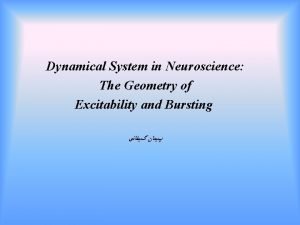A Comparison of Seasonal Hurricane Forecasts Dynamical Model

- Slides: 1

A Comparison of Seasonal Hurricane Forecasts: Dynamical Model versus Dynamical–Statistical Model Hui Wang, Lindsey N. Long, Arun Kumar NOAA/NWS/NCEP Climate Prediction Center, College Park, MD 20740 1. Background CFSv 2 forecast skill for ASO SST and U 200–U 850 To support NOAA Hurricane Season Outlooks, several forecast tools have been developed at CPC, including the high-resolution T 382 CFSv 2 dynamical model and the low-resolution T 126 CFSv 2 -based hybrid dynamical–statistical model. The goals are Fig. 2. Anomaly correlation skill of (a) T 382 CFSv 2 and (b) T 126 CFSv 2 for ASO SST, and (c) T 382 CFSv 2 and (d) T 126 CFSv 2 for ASO U 200–U 850. Boxes indicate the Niño-3 region and Atlantic hurricane Main Development Region (MDR). 1) To apply the hybrid model approach with the T 382 CFSv 2 for the Atlantic seasonal hurricane forecast, 2) To compare the forecast skills between the dynamical model and the dynamical–statistical model with T 382 CFSv 2, and 3) To compare the forecast skills between the T 382 CFSv 2 -based and the T 126 CFSv 2 -based hybrid models. 2. Data and methodology Observational data (1982– 2018) § August–November (ASON) Atlantic tropical storms (TS), hurricanes (H), and accumulated cyclone energy (ACE) index Fig. 2 Relationships between SST/U 200–U 850 and hurricane activity § Vertical Wind Shear (U 200–U 850): NCEP–DOE Reanalysis Fig. 3. Maps of correlation between detrended observed Atlantic ASON hurricanes and ASO SST in (a) observations (OBS), (b) T 382 CFSv 2 forecasts, and (c) T 126 CFSv 2 forecasts over the 1982– 2018 period. § T 382 CFSv 2: Hindcast/forecast initialized in July, 5 members § T 126 CFSv 2: Hindcast/forecast initialized in July, 24 members Methodology § A dynamical–statistical forecast tool is developed based on the empirical relationships between observed seasonal hurricane activity and model predicted SST/U 200–U 850 (predictors). § Forecast skill is cross-validated over the 1982– 2018 period. Fig. 4. Same as Fig. 3, but for ASO U 200–U 850 correlated with the observed Atlantic ASON hurricanes. Fig. 3 3. Results Variability of Atlantic tropical storms and hurricanes Fig. 1. Time series of observed August–November (ASON) Atlantic (a) tropical storms (TS), (b) hurricanes (H), and (c) accumulated cyclone energy (ACE) index from 1982 to 2018, and corresponding linear trend (blue line). Fig. 1 Large interannual variation + upward trend Fig. 5. Time series (1982– 2018) of ASON Atlantic hurricanes in observations (black), T 328 CFSv 2 dynamical forecasts (red), and T 382 (orange) and T 126 (blue) CFSv 2 -based hybrid dynamical– statistical model forecasts. High skill in both the Niño-3 region and MDR § Sea Surface Temperature (SST): NOAA OISSTv 2 Model data (1982– 2018) Comparison of forecast skills Fig. 4 Regions of high correlations in Figs. 3 and 4 are used to construct predictors for the dynamical–statistical model by averaging SST and vertical wind shear (VWS) over these regions. Predictors: § Niño-3 SST § Western MDR SST § MDR VWS U 200–U 850 Fig. 6. AC skill of the forecasts with the T 382 CFSv 2 dynamical model (red) and T 382 (orange) and T 126 (blue) CFSv 2 -based hybrid models for ASON Atlantic (a) tropical storms (TS), (b) hurricanes (H), and (c) ACE index, cross-validated over 1982– 2018 using different predictors derived from the CFSv 2 forecasts. Observed preseason North Atlantic SST is an additional predictor. 4. Summary and conclusions § A dynamical–statistical model was developed forecasting Atlantic seasonal hurricanes using SST and vertical wind shear as predictors derived from the T 382 CFSv 2 forecasts. § T 382 dynamical model vs. T 382 CFSv 2 -based hybrid model: The hybrid model has overall better skills than the dynamical model. § T 382 CFSv 2 -based hybrid model vs. T 126 CFSv 2 -based hybrid model: The low-resolution model has better skills than the highresolution model, likely due to more ensemble members.

